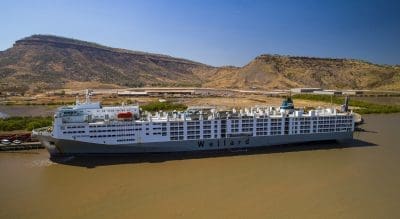MARKET insights contained in livestock vessel owner and charterer Wellard’s latest half yearly results report point to further signs of increasingly challenging conditions in Australia’s two largest cattle export markets.
 Wellard reported a net loss after tax of US $1.6 million (AUD $2m) for the first half of the 2021 financial year (June 1 to December 31, 2020), a similar result to the US $1.4 million loss (AUD $1.8m) it reported in the corresponding period of the previous financial year.
Wellard reported a net loss after tax of US $1.6 million (AUD $2m) for the first half of the 2021 financial year (June 1 to December 31, 2020), a similar result to the US $1.4 million loss (AUD $1.8m) it reported in the corresponding period of the previous financial year.
The owner and hirer of cattle and sheep export vessels had been on track to post a follow-up profit to match its full FY2020 result, executive chairman John Klepec said.
However, the sudden suspension of cattle exports from New Zealand in September 2020 following the tragic loss of the Gulf Livestock 1, her crew and cargo, and a longer than expected period in dry dock to maintain and upgrade the M/V Ocean Ute resulted in increased costs and reduced revenue.
The company is eyeing a more positive second half, Mr Klepec indicated, with a good forward charter book which includes the M/V Ocean Ute chartered until late June; the M/V Ocean Drover until late May; and the M/V Ocean Swagman until mid-May.
The report outlined a continued challenging market outlook for Australian livestock exporters.
Wellard noted that with live export prices for feeder steers currently in excess of AUD $4/kg, consumers in destination countries are turning to alternative proteins, impacting on importer margins and therefore demand for Australian livestock.
“This in turn is reducing exporter demand for charter vessels and creating greater competition among charter companies for the voyages that are being tendered,” the statement said.
It noted that feeder steer exports from Australia dropped by 25 percent in the second half of 2020 compared to the first half, and slaughter cattle exports dropped by 28pc, and sheep exports declined by 27pc.
Breeder cattle exports were less affected, falling by 7pc.
The reported noted that Meat & Livestock Australia has reported that Indonesian feedlots are currently stocked at only 40 percent of capacity, and Indonesia is seeking to import large numbers of cattle from Mexico, while the importation of Indian Buffalo Meat and boxed beef from Brazil and Australia was also forecast to increase considerably.
“This also due in part to transition away from wet markets to packaged product as a result of COVID-19 and movement restrictions,” it said.
In Vietnam beef sales were reported to be down by 70 to 80pc which the report suggested was due to market resistance to high Australian cattle prices.
Vietnamese feedlots are carrying an overhang of cattle that weren’t sold during the recent Tet festival. Tightening of movement into China was also forcing competing proteins back into the Vietnamese market, in competition with beef produced from live cattle, the statement said.
“As a result of the above, Wellard does not anticipate the recent contraction in live cattle export numbers from Australia will correct to any great degree in the coming six months to 30 June.
“Importers of beef and slaughter cattle have been unable to pass the increased price onto consumers, which has been exacerbated by the increased Australian Dollar.
“Fundamentally the very high prices cannot be sustained indefinitely with market participants accumulating substantial losses, likely to lead to some closure of processors for extended periods and in our markets, the substitution of supply sources.
“Reflecting this market dynamic, a large majority of confirmed future charters for Wellard vessels are to safely transport breeding cattle from Australia, New Zealand, and Uruguay to China.
“Additionally, the shift to alternative cattle supply sources, which we will actively participate in, are all much longer shipping routes.”
The fall in feeder and slaughter cattle export numbers from Australia in the past six months had prompted Wellard to increase its activity on the New Zealand to China and South America to China trade routes for Breeders in the first half of FY21, a trend that has continued into the second half of FY21, the company said.
